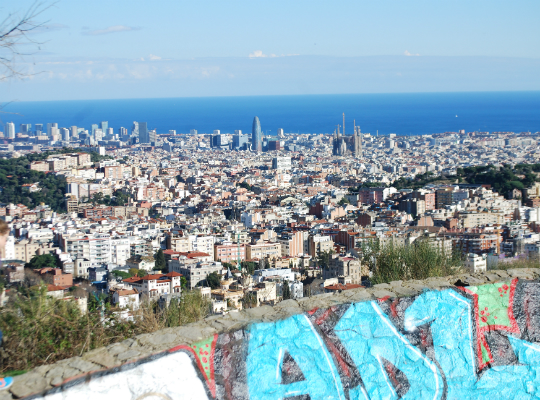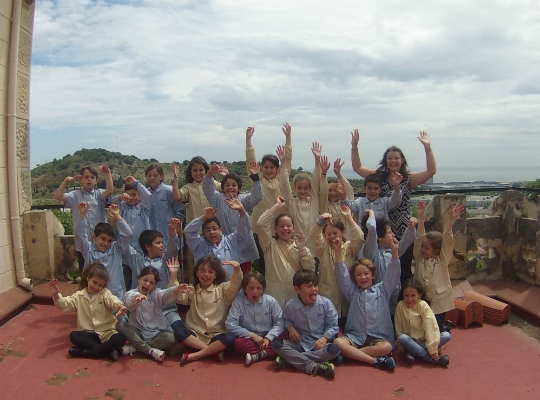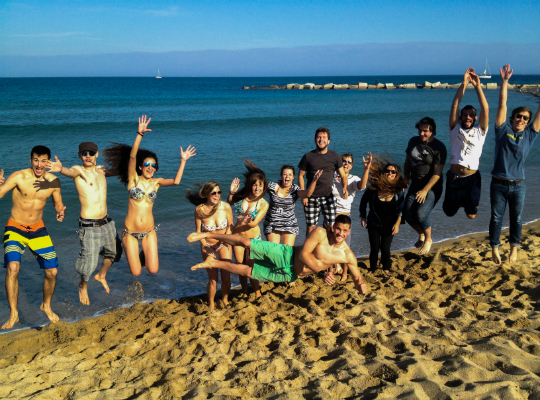Erasmus+ Journal (Issue 2) 2013/14
Birgit Fauland, Spain, Universitat de Barcelona, Mobility for Studies
Author: Birgit Fauland
History
Located at the foothills of the mountain range Collserola in the northern part of Barcelona the Campus Mundet of the University of Barcelona has an extensive history. Due to the fact to its surrounding of palm trees and many bushes and trees it's the most beautiful Campus for me. You can have a great view over the city including several chirp of green and orange coloured parrots while you are challenging with many stairs to reach the seminary rooms. There is also a second, more comfortable way to get to the seminary rooms - this would be a campus bus, which connects only 2 very close stations.
According to the history books Mundet was built as a prison in early days of the world war, later on transformed into an orphanage until 2 of the previous orphans decided to transform it into a school and a campus. This couple, named Mundet, explains the origin of the Campus and the Metro station.
Since I arrived in Barcelona, I know, that I'm not in Spain, but in Catalunya. This is a very strong difference which I recognized in many situations. It's hard to believe but the Catalans are more partriotic than the Italians, in every corner of the city you can find a Catalonya flag and if you tell an inhabitant that you are really proud to be in Spain, they glance at you with an evil eye. Due to the fact that Catalunya lost its independence 300 years ago (this year on the 11th of September it will be 300 years), they now fight to regain their independence and take every chance to vote for being an independent country.

Skyline Barcelona (Photo: Birgit Fauland)
Comparison of Educational Systems and Study
Brief description about the Education System of Spain/Catalonia:
In the early childhood education in Catalunya the the pre-compulsory education stage to children aged 0 to 6 years is given. They distinguish between junior or early childhood (0-3 years) and first or second cycle education (3-6 years). The main aim of early childhood education is to contribute to emotional and affective, physical and motor, social and cognitive development of children.
- Primary education is at the educational stage of compulsory and normally free, comprising six academic courses and is organized into three cycles of two years: initial cycle, half cycle and senior cycle. In general, they begin in the calendar year in which they reach 6 years until the age of 12 years. The purpose of primary education is to provide all students an education that will develop the personal skills and social skills, express the artistic sense, creativity and emotions, and learn the basics of history, geography and Catalan traditions that facilitate rooting.
- Compulsory Secondary Education (ESO) is free and comprises four academic years. It lasts from the age of 12 to 16.
- Bachillerato: There are three types of school: arts (via visual arts, design and satellite image and performing arts, music and dance), humanities and social sciences, and science and technology.
Comparison to Austria:
In Austria very young and pre-school children are often given to nurseries (Kinderkrippen) (for babies and very young children), to kindergardens (from age three to six) and pre-school classes (Vorschule - from age five). The first four years of compulsory education are completed in primary schools (Volksschule);
From age of ten the children can attend either a junior high school or secondary school (Hauptschule, or Kooperative Mittelschule), or a ‘new middle school’ (Neue Mittelschule) (educational experiment) or the lower grades of a higher general secondary school (allgemeinbildende höhere Schule (AHS) also called Gymnasium). All school types comprise four educational levels. The ninth school year (age 14-15) can be completed at a polytechnical school (Polytechnische Schule) (a school emphasising vocational orientation and preparation for an apprenticeship) or in other types of school.
- For the higher education from 14 - 18 there are Colleges for Higher Vocational Education or Academic Secondary school - upper level (finish with Matura - then: University)
- Private schools in Austria account for about 8% of the total number. Most publicly authorised private schools are denominational schools; in addition there are some schools which teach according to a particular system. Private schools are fee-paying establishments. There are no fees to be paid for state schools. The quality of State schools is very high in comparison to other education systems in Europe.
University Education:
In Spain the study for being a primary teacher takes 4 years, in Austria only 3 (but it's changing to 4 years now). At the Universitat de Barcelona every student receives more ECTS per course than in Austria. It's possible to receive 6 ECTS for one course in Spain, whereas in Austria you only receive 0,5 to 1 ECTS per each course. This , of course, leads to negative and positive aspects. If you get less ECTS per each semiary you have to attend more of them which offers a bigger variety of knowledge.
Courses
I attended 6 courses at University (including 2 language courses).
1. Aspectes Culturals dels Països de Parla Anglesa - 3 ECTS
Aims:
- To gain a basic insight into the vast cultural and social diversity in English-speaking nations from a historical and contemporary perspective.
- To acquire vocabulary and useful information for living abroad.
- To identify social and cultural issues that may be of interest as higher education students and future teachers.
The contents of this course are the cultural aspects of English speaking countries. For a good assessment you have to attend at least 80%, to make an individual presentation about a cultural topic. Furthermore there has to be held a group presentation about an English speaking country and several in class activities. There were many monologues of the teacher which was sometimes kind of boring but generally the course was good structured and interesting.
2.Llengua Anglesa per a l'Ensenyament
This course was structured like an English grammar course. It was especially for the students of the first semester, which have to work hard for their English skills. That's why the teacher offered us Erasmus students the possibility to do a "single assessment" where we didn't have to attend class but to do the in-class essays, tasks and the final exam. The English level was very low, embarrasing low, so I had no problems at all and didn't have to study for the exam.
3. Learning English Using Stories
This course was for practising telling stories in primary classes. From my point of view storytelling was a short but intensive course. We did many things during the lessons and of course at home which has changed my thinking about stories and even about telling them. There were presented many different stories for children and also the prework and activities after reading it with the children. There was no exam, only a short Symbaloo (which is an online platform where you can save interesting or useful internet links) and a summary of the course.
4. PRÀCTIQUES 3 - School Practice
I am proud of having had the possibility to complete my practice in the L'Escola Garbí Pere Vergésin Badalona. I had to do a practice of 120 hours in total, so I spent the Wednesdays and Thursdays there with the aim to gain as much insight in different classes for observing and assisting and at least also for teaching in a foreign country as possible.
The School Pere Vergéz is a half private and a half state school. It is located in the north of Badalona, founded by a teacher named Peter Verges. The school is named after him and is a very modern school, very well equipped. The school is equipped with the latest technology, such as iPads, beamers and laptops or even white/smart boards in every class. All children own a moodle access where they can find interactive exercises according to the book. School starts at 8:30am until 4:30pm.
The school is divided in 3 sectors; the infantile sector, the primary school and the secondary school (+ Bachillerato classes included). It is a private school where parents pay a lot each month. They don’t have to pay but they do it as a financial aid for the school. In primary there are 6 grades with each 2 classes. In secondary there are 4 grades with each 2 classes and in the Bachillerato grade there are also 2 grades with 2 classes. Each class in primary school has approximately 25 to 28 pupils in it. In secondary there are approximately 22 to 25 students in each class. Pupils in primary have to wear a special coat which has the colour blue or yellow. They can decide which colour they want but they have to wear it the whole day.
In Pere Vergés there are a lot of native speakers for English. There are 4 native speakers and 4 Spanish teachers who went to Great Britain or the U.S. for improving their English and can now speak almost like a native speaker. In school they teach only English except Eulália who was our Tutor for our practice. She is teaching German in secondary school as well.
I did a lot of microteachings and also I taught a few lessons in class. This was not easy at first because I had to observe the different routines and the everyday life of the school. My microteachings consist of several English lessons and some German lessons. In my primary class I had no opportunity to teach in Spanish but I had several other possibilities to help the teacher in class or outside when they went swimming.
Furthermore we had to write a diary entry every day to know exactly what we have done each day. These diaries consist of personal observations, impressions or important happenings. What was important to write the diaries: to write it always the same day or just a few days after because otherwise you would not memorize your days. It was also useful to write down my experiences and also my impressions and personal feelings about my day. I also wrote down when there were misunderstandings among the teachers to inform me right.
We also had to fill out several observation worksheets where we had to discover many aspects of the classroom, of the structure and organisation of the school and the interaction among the pupils. This was done every two weeks with a final feedback at our every two weeks tutorials. For me it was a good opportunity to look closer and discover new things.
Finally I want to mention one strong point – the really warm and enthusiastic way of the children treating us students, although the communication was so difficult – especially at the beginning. I'm happy to have received this great opportunity of teaching and at the same time I’m a bit proud of myself to have mastered all this challenge in a different country quite satisfying.

My class "Rosarar" - 2nd primary (Photo: Birgit Fauland)
Application process
At first I had to do an online application form with my data and my desired courses. The first difficult step was to find the courses online but I got good help from Cristina, who studied also at this faculty. In the end I had 6 courses to achieve 30 ECTS (including 2 language courses).
This first learning agreement was wrong because I couldn't take these courses. So the international office, which is really ambitous, gave me a list with possible courses for international students. I only had to fill a second learning agreement, stamp it in Graz and send it to Barcelona.
I received a welcoming email with all necessary information several weeks after.
Contact Information
Passeig de la Vall d'Hebron, 171
08035 Barcelona
España
Telèfon: 93 403 51 18
http://www.ub.edu/fprofessorat/
http://www.ub.edu/fprofessorat/ori/
Kontaktperson:
Natalia Fullana, PhD
Tutor of International Students
Office 134 (Llevant building)
Facultat de Formació del Professorat
Universitat de Barcelona
Passeig de la Vall d'Hebron, 171
08035 Barcelona
Tel.: +34 934 035 070 (office 134)
Accomodation
If you are in the Passatge de Ros 3 (English: blonde lanes) at "Bajos" - which means ground floor - and press the doorbell, the door to my apartment opens. This very modern (IKEA) designed apartment is located in the north of the city, only 5 minutes away from the famous Park Güell and right next to the metro station "El Coll / La Teixonera" (blue line). This tiny alleyway which does due to a very hilly area (we have always affectionately called it "we live in the mountains") a little descent, leads either to the metro station or bus V17 - the direct bus to the beach (by bus it takes approximately 40 minutes). However, to my university in Mundet there were only a total of 3 stations (including one change).
As soon as you enter the apartment, you will find yourself already in the living room, which is equipped with a large table, a super comfortable sofa and even a flat screen television. Right next door is the kitchen, which includes even an induction stove (attention while cooking: everything boils within a few seconds). The small hallway going, you will discover the 3 rooms, each equipped with a bed, a wardrobe, a desk and a shelf (all three rooms set up exactly the same). The bathroom is also very modern and there is also a covered outdoor room where the washing machine is.
The smaller rooms we have always used for guests and used the other two for learning and storing things. With the neighbors, we have made friends on the first day, they welcomed us in Spanish through a 15 minutes chatting.
Despite the best connection (either Metro or bus / night bus) it takes you approximately 30 minutes to the center and I am very glad to have found this apartment! Also, the owner is a true Spanish man, great temperament but always had an open ear to our problems. The rent for this apartment including all costs and unlimited internet for an approximately 85m² large apartment are 900 € a month. We split it up and paid 450€ each month per person.
Life
Life in Barcelona is roughly speaking as expensive as in Austria. The cost of living, such as food, beverages, costs of transportation, telephone and clothes are almost the same as in Graz. We had a great transport ticket which cost 100€ for 3 months including metro, bus and tram.
There were awesome bars and restaurants where beer or pintxos (related to tapas, the main difference being that pinchos are usually 'spiked' with a skewer or toothpick, often to a piece of bread) cost only 1€. These bars are rare and had to be discovered first. Also travelling was a huge part in my semester. I spent several days all around Spain and also took the possibility to fly. There are lots of cheap domestic flights in Spain, for example to Madrid, where we paid 100€ back and forth.
Finally I must admit that I spent a lot of money, much more money than I need in Graz, but this was an exception because it was a once in a lifetime experience which I would not have liked to miss.

My Erasmus friends (Photo: Nina Benda)